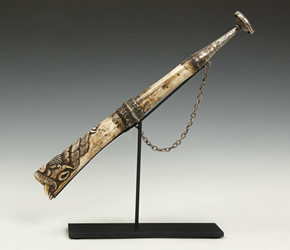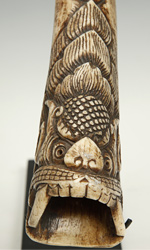Buddhist Kangling or Carved Bone Trumpet
 |
|
"Owing to the natural shortage of sacred human remains, this particular kangling bone trumpet was carved from the femur of a yak"
As in Western culture, objects derived from the human body were held in awe and reserved for use in intensely sacred or magical ceremonies. Fashioned as a bored horn from a human femur, the kangling or thighbone trumpet is said to produce a sound that is pleasing to the wrathful deities, but is terrifying to all evil spirits and maras, or demons. At first glance, one might assume that the kangling was assimilated from Himalayan shamanism or the ancient Bon religion that pre-dates the entry of Buddhism into Tibet. In fact, the thigh bone trumpet was not used by either of these older traditions. The long bones of the human body form a natural club or other utensil, but just as in Western culture, ancient societies did not use human remains casually. In fact, the reverse was true, ancestral bones being considered either sacred objects of reverence, or strictly taboo.
 |
|
In actuality, the kangling is part of an ensemble of sacred instruments that emerged from the tantric crucible of India some fifteen hundred years ago. There, both Shaviite and Buddhist yogins and yoginis lived as wandering ascetics, staying close to charnel grounds, wearing bone ornaments, and using a unique group of ritual implements, including the human skull cup. These same objects, worn by the deities described in tantric liturgies, also appeared in the great monasteries of the time, used for both their profound symbolic meaning, and as objects possessing inherent spiritual power. Buddhist tantric religion began arriving in Tibet and Bhutan around 800 A.D, and the kangling appeared in these Himalayan regions sometime over the next century.
The kangling is only used in Chöd Buddhist rituals (which should be performed outdoors in the open) along with the Chöd damaru and bell. In Tantric Chöd practice the practitioner, motivated by compassion, plays the kangling as a gesture of fearlessness, to summon hungry spirits and demons so that their hunger may be satisfied and their sufferings thereby relieved. It is also played as a way of “cutting off the ego.” Owing to the natural shortage of sacred human remains, this particular kangling bone trumpet was carved from the femur of a yak and fitted with a metal mouthpiece and suspension chain. In fact, Bhutan continues to be a source for sacred ritual implements for practitioners of the Buddhist Chöd traditions.
Download this Article: Kangling Carved Bone Trumpet.pdf